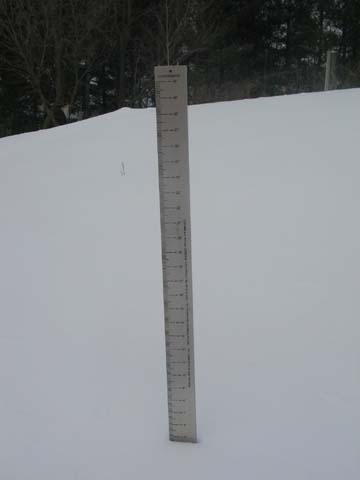 SWOP Snowfall Measurement Tips
SWOP Snowfall Measurement Tips
Wintertime in central Illinois can bring a wide array of weather challenges, to both forecasters and observers alike. Perhaps one of the most daunting, yet vital, tasks is measuring snowfall. Since snow is often accompanied by strong winds or becomes mixed with other precipitation types around this part of the country, proper measurements are almost always extremely difficult to obtain. This guide will provide a few tips that will hopefully make the job a bit easier. No matter how much care is taken, snowfall measurements will never be 100% accurate. The best advice we can provide is to follow the guidelines presented here and to try your best.
Tip #1: Choose a good location
Select a level, grassy area of your yard that is away from obstructions, such as trees, garages, and fences. Measuring too close to your house or deck could provide erroneously high totals due to blowing and drifting. Meanwhile, measuring on asphalt surfaces could yield low readings due to melting. The best bet is a flat, grassy spot in an open area of your yard.
Tip #2: Keep your grass clipped
Overestimates of snowfall can be obtained when measuring over tall grass, as your ruler will likely penetrate all the way down to ground level. Try to make sure your grass is cut short before winter arrives in order to mitigate this problem, otherwise keep in mind the height of your grass and take this into account when measuring snowfall.
Tip #3: Make a snowboard
Another way to measure snow that will avoid the melting issues associated with pavement and the potential overestimation problems with tall grass is to make your own snowboard. This is simply a piece of plywood approximately 2 feet by 2 feet that should be painted white in order to reflect incoming solar radiation. Before an expected snowfall, place the snowboard in a flat area of your yard away from trees and other obstructions. Be sure to mark the location of your board with a stake or a reflector so you'll know its location once it gets covered by snow. You can then take your measurements directly from the board. Of course, if strong winds have swept it clean, you will need to take your observation elsewhere. (See Tip #1)
Tip #4: Take multiple measurements
Do not rely on a single measurement, as blowing and drifting can result in highly variable amounts from place to place. Instead, take an average of at least 5 measurements from representative spots around your property.
Tip #5: Do not measure drifts
Large snow drifts should never be included within your averaged snowfall amount.
Tip #6: Use the right equipment
The easiest way to measure snow is with an NWS issued snowstick. This is simply a stick marked off in tenths of an inch. If you don't have a snowstick, a yard stick will work just fine as well!
Tip #7: Proper snowfall reporting
Once you've obtained a satisfactory measurement, please relay the data to us as soon as possible. The preferred method is via the SWOP e-mail account at: nwsliilx@noaa.gov Snowfall should be reported in tenths of an inch (i.e 0.5, 1.4, 6.0, 10.3).
Within the SWOP program, we encourage observers to take snowfall readings periodically through an event, then provide a storm-total once the snow has stopped. Please do not measure snow more frequently than once every three hours, as doing so could provide inflated accumulations.
Tip #8: Special circumstances
What do you do when it snows all night long, but when you get up in the morning, you notice the wind has swept virtually your entire yard clean? In this case, you should first try to find a representative spot somewhere in your general area to take measurements. This could be a nearby park, a neighbor's house, etc. -- any location where the snow did not get blown around as much. If that is not possible, your next option would be to try to make an estimate based on the snow in your own yard, and the amount of time it fell. If you have doubts about the accuracy of your data for whatever reason, please let us know when you send in your report. As was stated earlier, snowfall measurement will never be an exact science. If you encounter any other special snowfall circumstances or have any questions at all, do not hesitate to e-mail us at: nwsliilx@noaa.gov